
2016
-
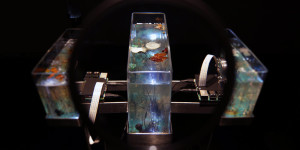
Time Displacement / Chemobrionic Garden
Robertina Šebjanič, Ida Hiršenfelder, Aleš Hieng – Zergon
Time Displacement – Chemobrionic Garden explores a relationship between hydrothermal chemistry, the passage of time, and the evolution of sound. The project consists of several small chemical garden formations in a water glass (sodium metasilicate) solution, to provide an insight into research on the origin of life and on chemical processes.
-
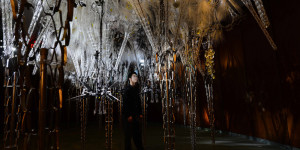
Sentient Chamber
Living Architecture Systems Group
Located at the National Academy of Sciences in Washington D.C., Sentient Chamber is a free-standing pavilion integrating innovative near-living technologies developed by the Living Architecture Systems Group. Sentient Chamber is composed of a flexible meshwork canopy, housing a network of kinetic mechanisms that use dense arrays of microprocessors and sensors.
-

Processing Foundation
Processing Foundation
The Processing Foundation’s mission is to promote software literacy within the visual arts, and visual literacy within technology-related fields. Our goal is to empower people of all interests and backgrounds to learn how to program and make creative work with code, especially those who might not otherwise have access to these tools and resources.
-

Nosaj Thing / Cold Stares ft. Chance The Rapper + The O’My’s
Daito Manabe, MIKIKO, TAKCOM, ELEVENPLAY, Rhizomatiks Research
This is a music video of “Cold Stares”, a collaboration between Los Angeles-based artist and beatmaker Nosaj Thing, who is actively working around the world, and rapper Chance The Rapper. A dance piece by two dancers was produced to express the message in the lyrics their mental situation and conflict searching for reason of being…
-

Project Nimbus
Dave Lynch, Mike Nix
Project Nimbus (2015) achieved the inaugural projection of moving images onto clouds from aircraft. The image (Horse in Motion – Muybridge 1878) is a shared cultural reference between art & science. Beyond the spectacle, genuine collaboration was underpinned by art as research, involving aviators, technologists, and cultural specialists, driven by the power of idea and…
-

Instruments of the Afterlife
Burton Nitta (Michael Burton & Michiko Nitta)
Instruments are created to transform contamination into valuable materials, by employing plants and engineered bacteria. Instead of mining material from geological sources and using fossil fuels that lead to environmental harm, could future generations use the contamination and pollution we leave behind to build their future world? Can they build balanced relationships with the natural…
-
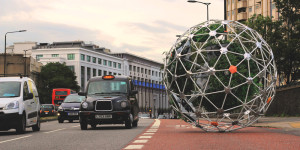
Hortum machina, B
Interactive Architecture Lab, William Victor Camilleri, Danilo Sampaio
Although plants lack nervous systems, they can, much like animals, become electro-chemically stimulated by their surrounding environment. Measuring this, we begin to understand the stimulus-response mechanisms that make up their primitive intelligence. Networked together we’ve harnessed their collective intelligence, exploring new forms of bio-cooperative interaction. The result is half garden, half autonomous vehicle a cybernetic…
-

HACKberry
exiii (JP)
HACKberry is an open-source 3D-printable bionic arm (i.e. motorized hand that a person missing a hand can control intuitively via muscle signals in their residual arm). All the technical data including 3D CAD file, software code, circuit diagram, and bill of materials are disclosed as open-source under Creative Commons license.
-

Floraform
Jessica Rosenkrantz, Jesse Louis-Rosenberg / Nervous System
Floraform is a generative design system inspired by the biomechanics of growing leaves and blooming flowers which explores the development of surfaces through differential growth. We created a simulation of a differentially growing elastic surface that functions as a digital garden. Within the system, we can explore how biological systems create form by varying growth…
-
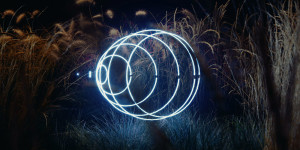
Floating Points – Silhouettes
Hamill Industries, Junior Martínez
The experimental music video for Floating Points (the name under which English musician and neuroscientist Sam Shepherd performs), portrays an abstract oscillating light that evolves through the music in different life forms. All lights are in-camera produced effects that are made by a self-developed light paint machine.
-
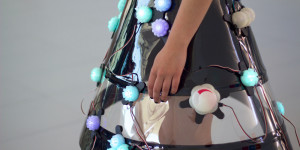
Environment Dress
uh513 ( María Castellanos & Alberto Valverde)
Environment Dress is a smart dress that measures the aggressiveness of the environment to analyze how it affects people’s mood and behavior.
-
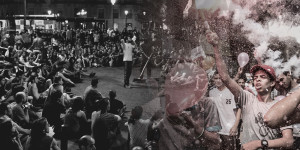
D-CENT – Decentralised Citizens ENgagement Technologies
D-CENT is a Europe-wide project that has brought together citizen movements and grassroots organizations that have revolutionized democracy in Europe in the past years, and is developing the next generation of open source, distributed, and privacy-aware tools for direct democracy and economic empowerment.

